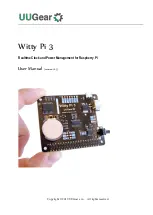
IOM-KHD-21E(a)-110_V1.1_EN
Copyright
©
2022 by KLINGER DIE ERSTE INDUSTRY CO., LTD.
3
2
IOM-KHD-21E(a)-110_V1.1_EN
Copyright
©
2022 by KLINGER DIE ERSTE INDUSTRY CO., LTD.
Standard 2-Piece Ball Valve
KHD-21E(a)
Standard 2-Piece Ball Valve
KHD-21E(a)
Table of Contents
Chapter I
Introduction
The manual is provided to ensure proper instal-
lation, operation & maintenance for Series 21E(a)
Standard 2-Piece Ball Valve, manufactured and sup-
plied by KLINGER DIE ERSTE Industry Co., Ltd. The
valves are identified by marking on the body or on a
name plate or both.
1.1 Contact Information
For information concerning warranties, or for ques-
tions pertaining to installation, operation or mainte-
nance of KLINGER DIE ERSTE products, contact:
KLINGER DIE ERSTE INDUSTRY CO., LTD.
5F-1, No.936, Sec. 4, Wen-Xin Road,
Taichung City, Taiwan 406
Phone: +886 4 22310059
Fax: +886 4 22360236
Email: [email protected]
To order replacement parts, contact KLINGER DIE
ERSTE sales at address listed above.
1.2 General Notes
The following instructions refer to KLINGER DIE
ERSTE Series 21E(a) Standard 2-Piece Ball Valve as
described in the KLINGER DIE ERSTE current cata-
log.
Keep the protective covers in place until the valve is
ready for installation. Valve performance depends
upon prevention of damage to ball surface. After re-
moving the cover make sure that the valve is com-
pletely open and free of obstructions, dirt, particles
or any materials that may cause seat or seal dam-
age.
Valves may contain a silicon-based lubricant for
transportation, which aids in the assembly of the
valve. Lubricant may be removed with a solvent if
found objectionable. Alternatively valves can be or-
dered free of lubricants upon request.
Certain ferrous valves contain phosphate material,
and are oil dipped during the course of manufac-
ture. However, the processes used are completely
non-toxic.
I Introduction
1.1 Contact Information
1.2 General Notes
1.3 Precautions and Warnings
1.4 Storage
II Installation
2.1 General Notes
2.2 Installation of Ends
III Operation
3.1 Handling
3.2 Cleaning
3.3 Manual Operation
3.4 Remote Operation
IV Maintenance
4.1 General Notes
4.2 Maintenance Frequency
4.3 Disassembly
4.4 Reassembly
4.5 Troubleshooting
4.6 Technical Data and Product Information
3
3
3
3
4
4
4
5
5
6
6
6
6
6
6
6
7
7
7
8
1.3 Precautions and Warnings
Choose the correct material of valve for different
applications before obtaining the valve. The user
should be aware of the operating situation, fluid
properties, and the possible outcomes when imple-
menting valves into the pipeline system. KLINGER
DIE ERSTE suggests that the user should make es-
timation beforehand.
Fluid undergoes property changes with respect
to outside factors, particularly fluid left inside the
sealed cavity. When temperature and pressure ex-
ceed allowable value, valve failure may occur.
The Series 21E(a) Standard 2-Piece Ball Valve are
generally not recommend for throttling services, due
to both fluid flow and ball leading edge may damage
or deform the resilient ball seats, and consequently
causing leakage problem. Further, high fluid velocity
or the presence of solid particles in suspension will
further reduce seat life in throttling applications.
Do not attempt to remove the cap from the body
during operation, especially with the presence of
high pressure in the pipeline system.
For safety concern, unstable fluid should not be
CAUTION:
Before removing valve from pipeline, operator
should be aware of that: media flowing through
the valve may be corrosive, toxic, flammable, or
of a contaminant nature. Where there is evidence
of harmful fluids having flowed through the valve,
the utmost care must be taken. It is suggested
that the following safety precautions should be
taken when handling valves.
1) Always wear eye shields.
2) Always wear gloves and footwear.
3) Wear protective headgear.
4) Ensure that running water is readily accessible.
5) Fire extinguisher must be obtainable if media is
flammable.
Check the line gauge to ensure that no pressure is
present at the valve. Ensuring media is released by
operating valve slowly to the half open position.
Ideally, the valve should be decontaminated when
the ball is in the half open position.






















